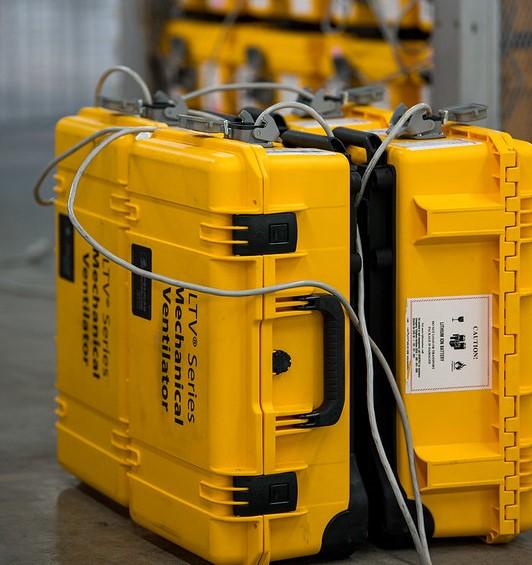Governors from coast to coast are working to share ventilators and make a plan to distribute the machines to hot spots as the COVID-19 pandemic sweeps across the United States.
Washington Governor Jay Inslee announced yesterday he was returning 400 ventilators to the Strategic National Stockpile.
"These ventilators are going to New York and others states hardest hit by this virus," Inslee said in a press statement. "I've said many times over the last few weeks, we are in this together. This should guide all of our actions at an individual and state level in the coming days and weeks."
Inslee also said he has purchased an additional 750 ventilators for his state that he expects to arrive in the coming weeks. Washington was the first state to confirm an imported COVID-19 case in America in late January. More than a month later, an outbreak at a Seattle-area nursing home suggested the virus has been stealthily spreading throughout the community for several weeks.
To date, Washington state has recorded 7,984 cases and 338 deaths. The state has seen a significant slowdown in cases in the last 2 weeks.
In California, Governor Gavin Newsom has been outspoken for the need for states to form a consortium to buy ventilators and supplies, rather than try to compete against each other with bids in the marketplace. Newsom announced today California would send 500 ventilators to the Strategic National Stockpile.
As of this afternoon, a total of 357,036 cases have been confirmed in all 50 states, including 10,522 deaths, according to a tracker maintained by the New York Times.
New York reports 599 new deaths
Today during his daily briefing from Albany, New York Governor Andrew Cuomo reported 599 more deaths in his state in the past 24 hours, and said the apex of cases inundating the tristate area could be arriving in the next few days. New York now has 130,689 cases and 4,758 deaths.
"We don't need any additional ventilators right now," Cuomo said, saying he's procured thousands of machines for state hot spots in recent days. Cuomo also extended the statewide ban on the closure of non-essential businesses through Apr 29, and increased the maximum fines given for failing to stay 6 feet apart in public from $500.00 to $1,000.00.
In New Orleans, COVID-19 has now taken more lives in the city than gun violence in 2019, according to the Times-Picayune. In total, Louisiana has tracked 14,867 cases, and 512 deaths. Over the weekend, the state received 200 more ventilators form the Strategic National Stockpile.
In Houston, NBC News reports that limited testing has kept officially confirmed numbers of the virus low, but intensive care units (ICUs) across the city are filling up with sick people with presumed COVID-19.
Michigan also reported an influx of cases, raising the state's total to 17,221 cases, and 727 deaths. According to the Detroit Free Press, those numbers represent 110 additional deaths between Sunday and Monday, and 1,503 new cases.
Finally, Illinois today reported a jump in more than 1,000 cases over the last 24 hours, raising state totals to 12,262 cases and 307 deaths.
CDC tracks pediatric COVID-19 cases
Today in Morbidity and Mortality Weekly Report, researchers from the Centers for Disease Control and Prevention (CDC) said 2% of COVID-19 infections in America have been in children, and so far three children have died during the pandemic.
Early research from China and other hot spots has shown that children are less likely to contract the virus than adults, and suffer severe illness at a much lower rate than the elderly, but this is the first study to look at how the disease is hitting American children specifically.
Researchers looked at 149,082 COVID-19 cases with known ages confirmed from Feb 12 to Apr 2, and found 2,572 (1.7%) were in children.
"Among those with available information, 73% of pediatric patients had symptoms of fever, cough, or shortness of breath compared with 93% of adults aged 18–64 years during the same period; 5.7% of all pediatric patients, or 20% of those for whom hospitalization status was known, were hospitalized, lower than the percentages hospitalized among all adults aged 18–64 years (10%)," the authors found.
The median age of pediatric patients was 11, and one third of pediatric patients were between the ages of 15 and 17.
Among the 295 pediatric cases for which information on both hospitalization status and underlying medical conditions was available, 28 of 37 hospitalized patients (77%), including all 6 patients admitted to an ICU, had one or more underlying medical condition. Among 258 patients who were not hospitalized, 30 patients (12%) had underlying conditions.
Healthcare groups ask White House to address shortages
On Apr 3, the American Lung Association published a letter to the Trump administration signed by 200 patient groups demanding immediate action to alleviate the shortage of ventilators and PPE.
"Our organizations urge the federal government to do significantly more to facilitate the timely manufacturing and distribution of ventilators and PPE through a process that is transparent, equitable, based on need and is non-competitive. A streamlined and predictable supply chain must emerge that is capable of lasting the duration of the pandemic," the letter reads.
Also today, the Department of Health and Human Services (HHS) announced that the CDC will give $186 million to state and local jurisdictions for increased COVID-19 testing and surveillance.
"State and local public health departments are on the frontlines of our fight against the pandemic, and these new resources will help them build the testing and surveillance capabilities needed to beat the new threat we face," said HHS Secretary Alex Azar.
According to a press release, the money will support lab equipment, supplies, staffing, shipping, infection control, surge staffing, monitoring of individuals, and data management, and will be used through the Emerging Infections Program (EIP) to enhance surveillance capabilities.






















